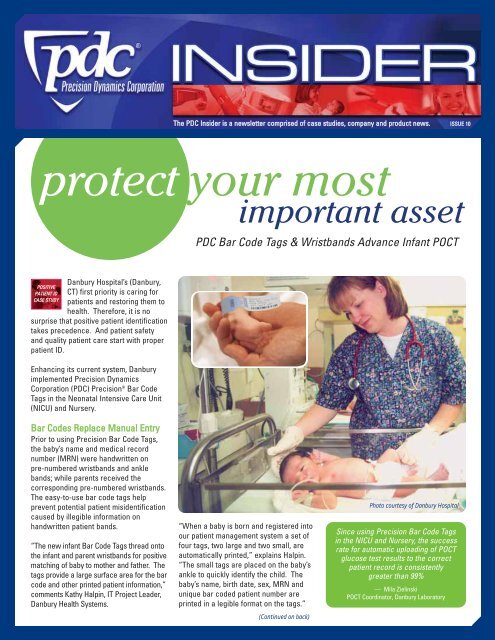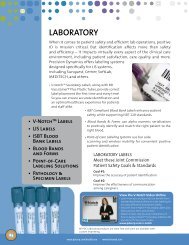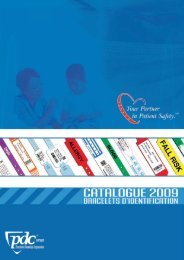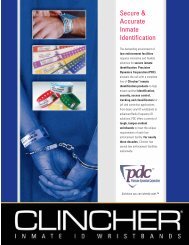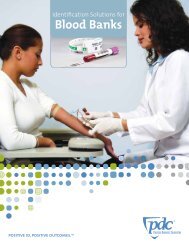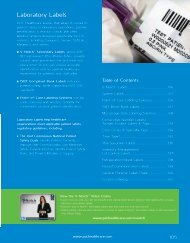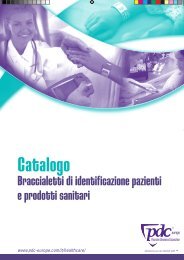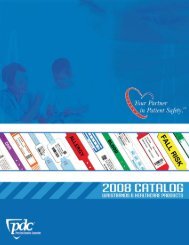PDC Bar Code Tags & Wristbands Advance Infant POCT - Precision ...
PDC Bar Code Tags & Wristbands Advance Infant POCT - Precision ...
PDC Bar Code Tags & Wristbands Advance Infant POCT - Precision ...
You also want an ePaper? Increase the reach of your titles
YUMPU automatically turns print PDFs into web optimized ePapers that Google loves.
The <strong>PDC</strong> Insider is a newsletter comprised of case studies, company and product news. ISSUE 10<br />
<strong>PDC</strong> <strong>Bar</strong> <strong>Code</strong> <strong>Tags</strong> & <strong>Wristbands</strong> <strong>Advance</strong> <strong>Infant</strong> <strong>POCT</strong><br />
POSITIVE<br />
PATIENT ID<br />
CASE STUDY<br />
Danbury Hospital’s (Danbury,<br />
CT) first priority is caring for<br />
patients and restoring them to<br />
health. Therefore, it is no<br />
surprise that positive patient identification<br />
takes precedence. And patient safety<br />
and quality patient care start with proper<br />
patient ID.<br />
Enhancing its current system, Danbury<br />
implemented <strong>Precision</strong> Dynamics<br />
Corporation (<strong>PDC</strong>) <strong>Precision</strong> ® <strong>Bar</strong> <strong>Code</strong><br />
<strong>Tags</strong> in the Neonatal Intensive Care Unit<br />
(NICU) and Nursery.<br />
<strong>Bar</strong> <strong>Code</strong>s Replace Manual Entry<br />
Prior to using <strong>Precision</strong> <strong>Bar</strong> <strong>Code</strong> <strong>Tags</strong>,<br />
the baby’s name and medical record<br />
number (MRN) were handwritten on<br />
pre-numbered wristbands and ankle<br />
bands; while parents received the<br />
corresponding pre-numbered wristbands.<br />
The easy-to-use bar code tags help<br />
prevent potential patient misidentification<br />
caused by illegible information on<br />
handwritten patient bands.<br />
“The new infant <strong>Bar</strong> <strong>Code</strong> <strong>Tags</strong> thread onto<br />
the infant and parent wristbands for positive<br />
matching of baby to mother and father. The<br />
tags provide a large surface area for the bar<br />
code and other printed patient information,”<br />
comments Kathy Halpin, IT Project Leader,<br />
Danbury Health Systems.<br />
“When a baby is born and registered into<br />
our patient management system a set of<br />
four tags, two large and two small, are<br />
automatically printed,” explains Halpin.<br />
“The small tags are placed on the baby’s<br />
ankle to quickly identify the child. The<br />
baby’s name, birth date, sex, MRN and<br />
unique bar coded patient number are<br />
printed in a legible format on the tags.”<br />
(Continued on back)<br />
Photo courtesy of Danbury Hospital<br />
Since using <strong>Precision</strong> <strong>Bar</strong> <strong>Code</strong> <strong>Tags</strong><br />
in the NICU and Nursery, the success<br />
rate for automatic uploading of <strong>POCT</strong><br />
glucose test results to the correct<br />
patient record is consistently<br />
greater than 99%<br />
— Mila Zielinski<br />
<strong>POCT</strong> Coordinator, Danbury Laboratory
Photo courtesy of Danbury Hospital<br />
“<strong>PDC</strong> met the challenge of finding an<br />
infant ID solution that is small and<br />
soft enough for our patients,<br />
acceptable to our clinical staff, and<br />
compatible with our printers.”<br />
<strong>Precision</strong>® <strong>Bar</strong> <strong>Code</strong> Tag<br />
— Kathy Halpin<br />
IT Project Leader, Danbury Health Systems<br />
(Continued from front)<br />
The large bar code tags slide onto the<br />
parent wristbands. For positive ID, these<br />
tags are printed with the mother’s and<br />
baby’s name along with the baby’s MRN<br />
and unique bar coded patient number.<br />
The mother receives either a <strong>PDC</strong><br />
Mother/<strong>Infant</strong> SnugFit ® Wristband or<br />
<strong>PDC</strong> CompuBand ® <strong>Bar</strong> <strong>Code</strong> Wristband<br />
at admission.<br />
Bedside Point-of-Care & Patient ID<br />
<strong>Precision</strong> <strong>Bar</strong> <strong>Code</strong> <strong>Tags</strong> allow healthcare<br />
personnel to instantly and accurately<br />
capture and verify data for medication<br />
administration, point-of-care testing<br />
(<strong>POCT</strong>), transfusion, specimen<br />
collection/tracking, surgical site safety<br />
and patient billing. Danbury uses the <strong>Bar</strong><br />
<strong>Code</strong> <strong>Tags</strong> to help extend infant protection<br />
to bedside point-of-care glucose testing.<br />
“Prior to implementing bar code tags,<br />
nurses would manually key in the 11-digit<br />
patient number or medical record number<br />
into the glucose meter, which was tedious<br />
and didn’t allow results to be entered<br />
automatically into our electronic medical<br />
record (EMR),” explains Halpin.<br />
“A pilot study we conducted indicated a<br />
tendency for errors associated with<br />
manual entry of the 11-digit patient ID<br />
number, and our <strong>POCT</strong> Committee decided<br />
not to implement automatic uploading to<br />
the glucose meter system until a reliable<br />
bar code wristband was in place,”<br />
says Dr. Salvador Sena, director of<br />
the hospital’s clinical chemistry<br />
laboratory and chair of the hospital’s<br />
<strong>POCT</strong> Committee.<br />
The unique bar code patient number on<br />
the tags allow nurses to match the<br />
glucose <strong>POCT</strong> results by scanning the<br />
patient bar code tag with the glucose<br />
meter which automatically uploads the<br />
results to the patient’s laboratory and<br />
medical record.<br />
Since using <strong>Precision</strong> <strong>Bar</strong> <strong>Code</strong> <strong>Tags</strong> in<br />
the NICU and Nursery, the success rate<br />
for automatic uploading of <strong>POCT</strong> glucose<br />
test results to the correct patient record is<br />
consistently greater than 99%, according<br />
to Mila Zielinski, <strong>POCT</strong> Coordinator in the<br />
hospital’s laboratory. Test results and<br />
trends can now be viewed and analyzed<br />
on the EMR.<br />
“<strong>PDC</strong> met the challenge of offering an<br />
infant ID solution that is small and soft<br />
enough for our patients, acceptable to<br />
our clinical staff, and compatible with<br />
our printers,” said Halpin.<br />
Auto ID for Medication Administration<br />
The success of the glucose <strong>POCT</strong> and<br />
patient matching led the laboratory to<br />
implement the same efficient system for<br />
phlebotomy draws using the patient bar<br />
code tag at the bedside. Danbury plans to<br />
use the tags to maximize patient safety for<br />
medication administration. For instance,<br />
the labels on the IV bags will contain the<br />
patient’s unique bar coded number.<br />
<strong>PDC</strong> bar code solutions help healthcare<br />
professionals achieve the “Five Rights of<br />
Medication Safety” by accurately<br />
matching the right patient to the right<br />
drug, dose, time, and route. The bar code<br />
tags also meet the requirements of JCAHO<br />
for positive patient ID, HIPAA for<br />
protection of patient safety, and AHA to<br />
reduce risk of lost or transferred data.<br />
About Danbury Hospital<br />
For 120 years, Danbury Hospital’s mission in western<br />
Connecticut and nearby New York has been to advance<br />
the health and well-being of people in the community.<br />
Danbury Hospital has emerged as a regional medical<br />
center with centers of excellence in cardiovascular,<br />
cancer, digestive disorders, orthopedic, bariatric<br />
(weight loss surgery), high-risk pregnancy and neonatal<br />
medicine. The Hospital is a University Teaching<br />
Hospital of New York Medical College and ranked<br />
among the nation’s 100 Top Hospitals for its better<br />
patient safety, lower length of stay and higher rate of<br />
growth and responsiveness to the community, when<br />
compared to its peer teaching hospitals.<br />
<strong>Precision</strong> Dynamics Corporation®, <strong>Precision</strong>® <strong>Bar</strong> <strong>Code</strong> Tag, SnugFit®, and CompuBand® are registered trademarks of <strong>Precision</strong> Dynamics<br />
Corporation. All other product names, company names, marks, logos and symbols mentioned herein are trademarks of their respective owners.<br />
<strong>Precision</strong> Dynamics Corporation<br />
13880 Del Sur Street<br />
San Fernando, CA 91340-3490 USA<br />
Solutions you can identify with.<br />
For questions and input please call<br />
800.772.1122 or 818.897.1111<br />
Email: info@pdcorp.com<br />
C-110-0806 E-10,000 8/06<br />
www.pdc-healthcare.com


